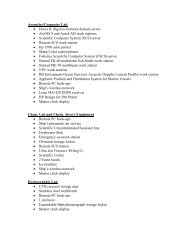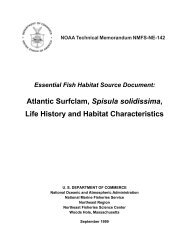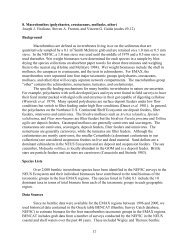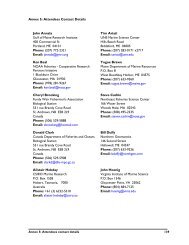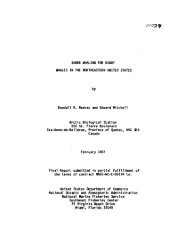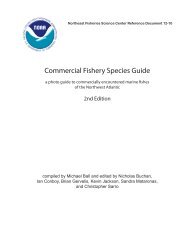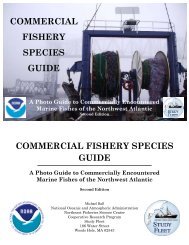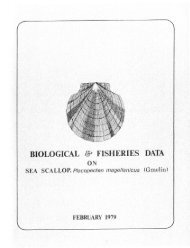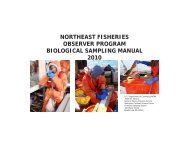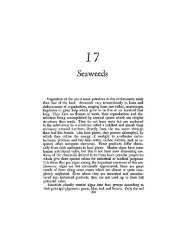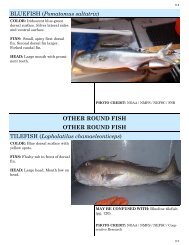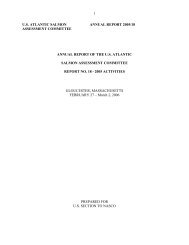Scup, Stenotomus chrysops, Life History and Habitat Characteristics
Scup, Stenotomus chrysops, Life History and Habitat Characteristics
Scup, Stenotomus chrysops, Life History and Habitat Characteristics
You also want an ePaper? Increase the reach of your titles
YUMPU automatically turns print PDFs into web optimized ePapers that Google loves.
fish eggs <strong>and</strong> larvae (Bowman et al. 1987). Copepods<br />
<strong>and</strong> mysids are important to post-larvae <strong>and</strong> early<br />
juveniles, while bivalve mollusks are more commonly<br />
eaten by larger fish (Richards 1963b; Bowman et al.<br />
1987; Michelman 1988). Allen et al. (1978) reported<br />
amphipods, polychaetes, copepods, <strong>and</strong> other small<br />
crustaceans were eaten by a small sample of juvenile scup<br />
in southern New Jersey, which is consistent with<br />
Northeast Fisheries Science Center (NEFSC) data [Figure<br />
2; see Reid et al. (1999) for a discussion of NEFSC food<br />
habitats data]. Michelman (1988) reported that scup only<br />
eat when they are in a school <strong>and</strong> the relative importance<br />
of major prey taxa varies seasonally. Baird (1873)<br />
reported prey were "rooted out of the s<strong>and</strong> or mud."<br />
Juvenile <strong>and</strong> adult scup near an artificial reef in lower<br />
Delaware Bay ate a mix of hard-surface epifauna <strong>and</strong><br />
s<strong>and</strong> bottom infaunal prey, including amphipods<br />
(caprellids <strong>and</strong> others), razor clams (Ensis directus),<br />
hydroids, blue mussels (Mytilus edulis), anemones, <strong>and</strong><br />
mysids (F. Steimle, unpublished data). In Raritan Bay,<br />
scup 9-12 cm FL ate a variety of benthic infaunal <strong>and</strong><br />
epifaunal invertebrates including polychaetes, copepods,<br />
small mollusks, <strong>and</strong> hydroids; dietary composition varied<br />
among areas within the bay (Steimle et al., in review).<br />
Michelman (1988) estimated that juvenile scup in<br />
Narragansett Bay (Rhode Isl<strong>and</strong>) consumed 0.6-1.7 g dry<br />
wt/m 2 of benthic prey between June 1 <strong>and</strong> September 30.<br />
The daily food ration of juvenile scup was 3.49-3.99% of<br />
dry body weight (depending on method used), or about<br />
5% of their body weight per day.<br />
Adult scup are also benthic feeders <strong>and</strong> forage on a<br />
variety of prey, including small crustaceans (including<br />
zooplankton), polychaetes, mollusks, small squid,<br />
vegetable detritus, insect larvae, hydroids, s<strong>and</strong> dollars,<br />
<strong>and</strong> small fish (Goode 1884; Nichols <strong>and</strong> Breder 1927;<br />
Hildebr<strong>and</strong> <strong>and</strong> Schroeder 1928; Bigelow <strong>and</strong> Schroeder<br />
1953; Oviatt <strong>and</strong> Nixon 1973; Maurer <strong>and</strong> Bowman 1975;<br />
Morse 1978; Sedberry 1983; Figure 2). As scup grow,<br />
their diets include larger prey. Bowman et al. (1976)<br />
found that polychaetes were more important in the diets<br />
of scup off southern New Engl<strong>and</strong> <strong>and</strong> anthozoans were<br />
more important in the Middle Atlantic Bight. Sedberry<br />
(1983) reported that during the fall migration off New<br />
Jersey scup fed mainly on amphipods, polychaetes, <strong>and</strong> to<br />
a lesser extent on decapod crustaceans, copepods, snails,<br />
<strong>and</strong> other small invertebrates. Adults also prey on small<br />
benthic invertebrates, although feeding <strong>and</strong> growth appear<br />
to be reduced during the winter.<br />
At times <strong>and</strong> in certain areas, scup diets overlap those<br />
of red hake (Urophycis chuss) <strong>and</strong>, depending on scup<br />
size, those of silver hake (Merluccius bilinearis) <strong>and</strong> Gulf<br />
Stream flounder (Citharichthys arctifrons) (Sedberry<br />
1983). Langton (1982) found that although the diets of<br />
scup overlapped those of several other demersal species,<br />
there was little prey overlap with cod (Gadus morhua) or<br />
silver hake off New Engl<strong>and</strong>, even though they have<br />
similar benthic diets. Jeffries <strong>and</strong> Terceiro (1985)<br />
Page 3<br />
hypothesized that an exp<strong>and</strong>ing scup population in<br />
Narragansett Bay seemed to replace the winter flounder<br />
(Pseudopleuronectes americanus) because both species<br />
have similar diets; if abundance of winter flounder were<br />
reduced, more prey could be available for benthic-feeding<br />
species such as scup. This dietary similarity was also<br />
found in a recent fish food habit study in Hudson-Raritan<br />
Bay (Steimle et al., in review).<br />
During inshore residency, scup gradually accumulate<br />
food reserves from the spring into the fall. The mean<br />
caloric content increases from 24.2 kj/g ash-free dry<br />
weight of whole scup in the spring to 28.1 kj/g ash-free<br />
dry weight in the fall (Steimle <strong>and</strong> Terranova 1985). This<br />
stored energy can support the extra dem<strong>and</strong>s of migration,<br />
reduced feeding in winter, <strong>and</strong> gonadal development.<br />
Feeding may be minimal during the winter because there<br />
is so little growth (Bigelow <strong>and</strong> Schroeder 1953).<br />
PREDATION AND MORTALITY<br />
Larvae are probably preyed on by a variety of<br />
planktivores, including medusae, crustaceans, <strong>and</strong> fishes.<br />
Small or juvenile scup are heavily preyed on by bluefish<br />
(Pomatomus saltatrix), Atlantic halibut (Hippoglossus<br />
hippoglossus), cod, various sharks, striped bass (Morone<br />
saxitilus), weakfish, goosefish (Lophius americanus),<br />
silver hake, <strong>and</strong> other coastal fish predators (Baird 1873;<br />
Smith 1898; Jensen <strong>and</strong> Fritz 1960; Schaefer 1970; Morse<br />
1978; Sedberry 1983). Baird (1873) reported that cod ate<br />
large numbers of small scup on Nantucket Shoals in late<br />
November. Wading <strong>and</strong> diving shorebirds are also<br />
potential predators during the summer.<br />
The NEFSC bottom trawl survey data on food habits<br />
lists the following species as predators of scup: dusky<br />
shark (Carcharhinus obscurus), s<strong>and</strong>bar shark (C.<br />
plumbeus), smooth dogfish, spiny dogfish (Squalus<br />
acanthias), Atlantic sharpnose shark (Rhizoprionodon<br />
terraenovae), Atlantic angel shark (Squatina dumeril),<br />
Atlantic torpedo (Torpedo nobiliana), bluntnose stingray<br />
(Dasyatis say), silver hake, bluefish, summer flounder,<br />
black sea bass, weakfish, northern stargazer (Astroscopus<br />
guttatus), goosefish, inshore lizardfish (Synodus foetens),<br />
<strong>and</strong> king mackerel (Scomberomorus cavalla).<br />
Another potential source of mortality is disease.<br />
Disease can be initiated by direct epidermal exposure or<br />
through feeding on contaminated prey. <strong>Scup</strong> had fin rot<br />
in the degraded inner New York Bight <strong>and</strong> Hudson-<br />
Raritan estuary (Mahoney et al. 1975). Benthic<br />
invertebrate prey commonly eaten in the New York Bight<br />
were contaminated with several toxic heavy metals<br />
(Steimle et al. 1994).<br />
MIGRATION<br />
As inshore water temperatures decline to < 8-9 o C in



